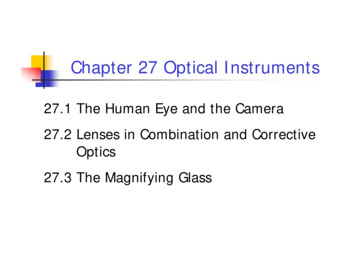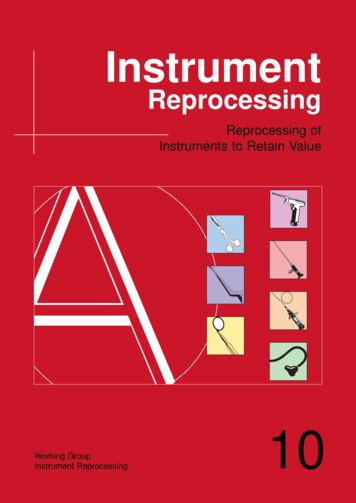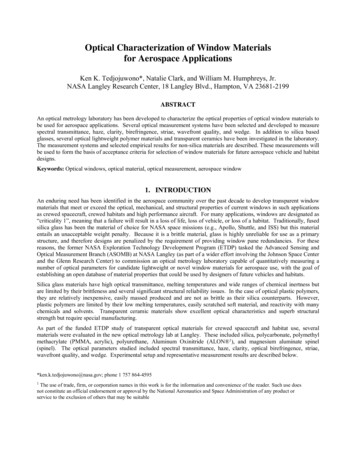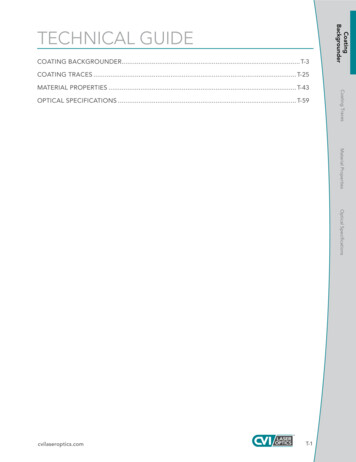
Transcription
Chapter 27 Optical Instruments27.1 The Human Eye and the Camera27.2 Lenses in Combination and CorrectiveOptics27.3 The Magnifying Glass
Figure 27–1 Basic elements ofthe human eye!Light enters theeye through thecornea and thelens. It is focusedonto the retina bythe ciliarymuscles, whichchange the shapeof the lens.
Figure 27–2 Image productionin the eye!The eye produces a real, invertedimage on the retina.
Figure 27–3 Accommodationin the human eye!(a) When the eye isviewing a distantobject the ciliarymuscles are relaxedand the focal lengthof the lens is at itsgreatest. (b) Whenthe eye is focusingon a near object theciliary muscles aretensed, changingthe shape andreducing the focallength of the lens.
Cilliary muscles pull on lens. This causes itTo change shape. From the lens-makers formulathis changes the focal length of the lens.We see objects at differentdistance by changingthe shape of our eye lens.ACCOMODATION
***Images in the human eyeIn the human eye, a real, inverted image is formed ona light-sensitive surface, called the retina.Accommodation is the process by which the focal lengthof the eye is automatically adjusted , so that objectsat different distance produce focused images on theretina.Near pointThe near point of the eye is the point nearest the eyeat which an object can be placed and still have asharp image produced on the retina. For a normal eye,the near point is located 25cm from the eye.Far pointThe far point of the eye is the location of thefarthest object on which the fully relaxed eye canfocus. For a normal eye, the far point is located atinfinity.
Figure 27–4 Basic elements ofa camera!A camera forms a real,inverted image onphotographic film. Thecamera focuses bymoving the lens backand forth relative to thefilm. Unlike theadjustable shape of theeye, the shape of thecamera lens remainsfixed.
Figure 27–5 A two-lens system!In this system, a convex and a concave lens are separated by 50.0 cm. (a) Anobject is placed 20.0 cm to the left of the convex lens, whose focal length is 10.0cm. (b) The image formed by the convex lens is 20.0 cm to its right. This imageis the object for the concave lens. (c) The object for this lens is 30.0 cm to itsleft. Since the focal length of this lens is -12.5 cm, it forms an image 8.82 cm toits left. This is the final image of the system.
***Nearsighted and farsightedA nearsighted (myopic) eye is one that canfocus on nearby objects, but not on distantones. This can be corrected by wearingeyeglasses or contact lenses made fromdiverging lenses. A farsighted (hyperopic)eye can see distant objects clearly, but notthose close up. Farsightedness can becorrected by using converging lenses.Refractive powerThe refractive power of a lens is measuredin diopters and is given by 1/f, where f isthe focal length of the lens in meters. Aconverging lens has a positive refractivepower, while a diverging lens has a negativerefractive power.
Figure 27–6 Eye shape andnearsightedness!An eye that is elongated can causenearsightedness. In this case, an object atinfinity comes to a focus in front of the retina.
When an object is infinitely far ( 20 m) from our eyes.The eye is fully relaxed, meaning that the lens has leastcurvature and longest focal length.Many people cannot see distant objects clearly.They can see perfectly well objects that are not distant.The point beyond which distant objects appear blurred is calledthe FAR POINTThe reason for this is that their eye lens cannot fully relax.Due to problems with the muscles or the lens itself.Far pointThe far point of the eye is the location of the farthest object onwhich the fully relaxed eye can focus. For a normal eye, the farpoint is located at infinity.Nearsightedness or myopic
Figure 27–7 Correctingnearsightedness!A diverging lens in front of the eye can correct fornearsightedness. The concave lens focuses light from anobject beyond the far point to produce an image that is atthe far point. The eye can now focus on the image of theobject.
Eye-lens can’t get thin enough. Correct using a diverging lens
Figure 27–8 Refractive power!Refractive Power. Lens b has morerefractive power. A shorter focal lengthand greater number of DioptersA lens with a shorterfocal length, as in(b), has morerefractive powerthan one with alonger focal length,as in (a), in thesense that it bendsincoming rays oflight more sharply.
Problem: A near sighted person has a far point located only 220 cmfrom her eyes. Determine the focal length of contact lenses that willenable this person to see distant objects clearly. What is the power ofthese lenses.Solution:Remember a diverging lens is required to correct near sightedness.That is, the focal length of the lens is negative.d0 1 0d01111 d i f 220cm 2.2mf d0 di diP 11 0.45 Diopterf (m) 2.2Glasses are generally worn 2 cm in frontof the eye. f 218 cmSee example 27.2di is negative so f is negative and thelens must be concave or diverging
Figure 27–10 Eye shape andfarsightedness!An eye that is shorter than normal can causefarsightedness. Note that an object inside the nearpoint comes to a focus behind the retina.
When an object is nearby ( 1-2 m).The eye is fully contracted, meaning that the lens has largecurvature and shortest focal length.Many people cannot see objects clearly that are close up.They can see perfectly well objects that are distant.The point beyond which close-up objects appear blurred is calledthe NEAR POINTNear pointThe near point of the eye is the point nearest the eye at which anobject can be placed and still have a sharp image produced on theretina. For a normal eye, the near point is located 25cm from the eye.The reason for this is that their eye lens cannot fully contract.Due to problems with the muscles or the lens itself.far-sightedness or hyperopic
Figure 27–11 Correctingfarsightedness!A converging lens in front of the eye can correct forfarsightedness. The convex lens focuses light from an objectinside the near point to produce an image that is beyond thenear point. The eye can now focus on the image of the object.
Eye-lens can’t get “fat” enough. Correct using a converging lens
Hyperopia-correct using a converging lens.The lens images nearby objects further from the eye than the near point.With the corrective aid, the IMAGE of the object can be seen clearly.
Problem: A far sighted person person cannot see clearly objects that arecloser to the eye than 73 cm. Determine the focal length of contact lenses that willenable this person to read a magazine at a distance of 25 cm.Solution:Remember a converging lens is required to correct far sightedness.That is, the focal length of the lens is positive.Far sighted-objects close up are blurred.Distant objects need to be imaged at most 73 cm from the eye.d 0 25cm, d i 73cmdi do(25)( 73)f 38cm(25 73)d0 diP 11 2.6 Diopterf (m) 0.38focal length positive converging lens
Problem: A college professor can see objects clearly only if they are between 70and 500 cm from his eyes. His optometrist prescribes bifocals that enable him tosee distant objects clearly through the top half of the lenses and read studentspapers at a distance of 25 cm through the lower half. What are the powers of thetop and bottom lenses.Top:do ,di 500 cm 5.0 m (image on object side).11111 0.20 D .P f d d 5.0 moiBottom: do 25 cm 0.25 m,P di 70 cm 0.70 m (image on object side).11 2.6 D .0.25 m 0.70 m
Figure 27–12 Angular size anddistance!The angular sizeof an objectdepends on itsdistance from theeye, even thoughits height, h0,remains the same.
***Angular sizeThe angular size of an object is the angle that it subtendsat the eye of the viewer. For small angles, the angular sizein radians is ho /do, where ho is the height of the object anddo is the object distance.Angular magnificationThe angular magnification M of an optical instrument is theangular size (θ') of the final image produced by theinstrument divided by the reference angular size(θ) of the object, which is seen without the instrument:M θ'/θMagnifying glassA magnifying glass is usually a single converging lens thatforms an enlarged, upright, and virtual image of an objectplaced at or inside the focal point of the lens. For amagnifying glass help close to the eye, the angularmagnification is approximately (1/f - 1/di)N, where f is thefocal length of the lens, di is the image distance, and N isthe distance of the viewer's near point from the eye.
Figure 27–13 How a simplemagnifier works(a) An object viewedwith the unaided eye atthe near point of theeye subtends an angleη λ h0/N. (b) With amagnifier, the objectcan be viewed from thedistance f, which is lessthan N. As a result, theangular size of theobject is η ' λ h0/f,which is greater than η.
A nearsighted (myopic) eye is one that can focus on nearby objects, but not on distant ones. This can be corrected by wearing eyeglasses or contact lenses made from diverging lenses. A farsighted (hyperopic) eye can see distant objects clearly, but not those close up. Farsightedness can be corrected by using converging lenses. Refractive powerFile Size: 1MB











